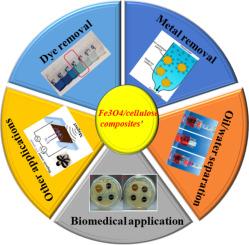Recent progresses in the development of magnetic Fe3O4 nanoparticles supported cellulose-based composites: A review
IF 5.4
3区 化学
Q1 CHEMISTRY, INORGANIC & NUCLEAR
引用次数: 0
Abstract
Cellulose is a readily available, renewable, natural polymer and biodegradable that can be used to make polymer nanocomposites. Inorganic-organic composites are currently gaining popularity due to their flexibility. Hybrid nanocomposites made of cellulose and magnetic nanoparticles (NPs) have received a lot of interest over the past few years, because of their strong magnetic, chemical stability, biocompatibility, and simplicity of functionalization, Fe3O₄ nanoparticles are frequently utilized in cellulose nanostructures. These characteristics make them perfect for applications including medication administration, adsorption, catalysis, and smart materials. In this review, we summarize the current state-of-the-art manufacturing techniques for Fe3O4 supported cellulose-based composites, with a particular emphasis on their characteristics and ongoing study advancements related to the utilization of Fe3O4 supported cellulose-based composites for metal adsorption, water/oil separation, dye degradation, biomedical and other applications. This work offers a critical and comparative evaluation of Fe3O4/cellulose hybrid composites, highlighting synthesis techniques, multifunctional applications, and methodically identifying current research gaps and future directions, in contrast to earlier reviews that primarily provide descriptive overviews. From 2010 to 2025, pertinent literature was methodically gathered from major databases such as Web of Science, Scopus, and ScienceDirect using keywords like “cellulose nanocomposites,” “Fe3O4 nanoparticles,” and “hybrid composites.” Studies that documented physicochemical characteristics, synthesis methods, or applications were included, while purely theoretical or irrelevant works were excluded. Furthermore, we will underline that this review outlines the future research areas and upcoming issues, thereby distinguishing it from generic narrative reviews.

磁性纳米Fe3O4负载纤维素基复合材料的研究进展
纤维素是一种易得、可再生、可生物降解的天然聚合物,可用于制造聚合物纳米复合材料。无机-有机复合材料由于其灵活性,目前越来越受欢迎。在过去的几年中,由纤维素和磁性纳米颗粒(NPs)制成的杂化纳米复合材料受到了广泛的关注,因为它们具有强磁性、化学稳定性、生物相容性和简单的功能化,硫酸铁纳米颗粒经常用于纤维素纳米结构。这些特点使其完美的应用,包括药物管理,吸附,催化和智能材料。在这篇综述中,我们总结了目前最先进的Fe3O4负载纤维素基复合材料的制造技术,特别强调了Fe3O4负载纤维素基复合材料在金属吸附、水/油分离、染料降解、生物医学等应用方面的特点和正在进行的研究进展。本研究对Fe3O4/纤维素混合复合材料进行了批判性和对比性评价,突出了合成技术,多功能应用,并系统地确定了当前的研究差距和未来的方向,而不是早期的综述主要提供描述性概述。从2010年到2025年,通过“纤维素纳米复合材料”、“Fe3O4纳米颗粒”和“混合复合材料”等关键词,系统地从Web of Science、Scopus和ScienceDirect等主要数据库中收集相关文献。包括记录物理化学特性、合成方法或应用的研究,而排除纯理论或不相关的研究。此外,我们将强调这篇综述概述了未来的研究领域和即将出现的问题,从而将其与一般的叙述性综述区分开来。
本文章由计算机程序翻译,如有差异,请以英文原文为准。
求助全文
约1分钟内获得全文
求助全文
来源期刊

Inorganic Chemistry Communications
化学-无机化学与核化学
CiteScore
5.50
自引率
7.90%
发文量
1013
审稿时长
53 days
期刊介绍:
Launched in January 1998, Inorganic Chemistry Communications is an international journal dedicated to the rapid publication of short communications in the major areas of inorganic, organometallic and supramolecular chemistry. Topics include synthetic and reaction chemistry, kinetics and mechanisms of reactions, bioinorganic chemistry, photochemistry and the use of metal and organometallic compounds in stoichiometric and catalytic synthesis or organic compounds.
 求助内容:
求助内容: 应助结果提醒方式:
应助结果提醒方式:


